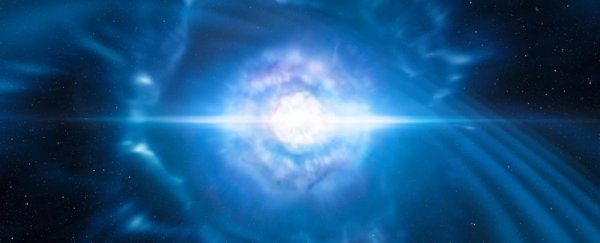The incredible gravitational wave event that gave us colliding neutron stars and pictures of colliding neutron stars is the astronomical gift that just keeps on giving. And it looks like it's given us yet another new thing to study - the lowest-mass black hole ever found.
Gravitational waves from high-mass mergers start before the objects actually collide, so when the signal from GW170817 came in on August 2017, all available telescopes around the world turned to observe what was occurring 130 million light-years away.
One of those was NASA's Chandra X-ray Observatory from its vantage point in orbit around Earth. And it didn't just capture the event itself. It continued to observe GW170817 for months after the collision, collecting the X-ray data that would reveal the complex dynamics occurring in the newly created object.
The gravitational wave detections prior to GW170817 were a lot more massive, occurring between pairs of black holes. This means that the objects that resulted from those collisions would be bigger black holes.
But with GW170817, the outcome was a little less certain. That's because neutron stars and black holes are both the end points of the life cycle of a high-mass star.
Once the core of a star has fused to iron, it squeezes the protons and electrons into neutrons and neutrinos. The neutrinos escape, but the neutrons are incredibly densely packed into a core between just 10 and 20 kilometres (6-12 miles) in diameter.
It's been theorised that if this core is less than about three stellar masses, the pressure of this density can support a neutron star. If the core is more than this mass, it collapses into a black hole.
The neutron stars involved in GW170817 were very small, just 1.1 and 1.6 stellar masses. When they combined, they created an object that would have been around 2.7 stellar masses.
This is below the 3 stellar masses estimate, but this is where it gets tricky. We've never observed a neutron star higher than 2.3 stellar masses, or a black hole smaller than around 3.7 stellar masses to 5 stellar masses, so where the lines fall in between is still a little bit of a mystery.
This means that GW170817 could either be a very large neutron star, or a very small black hole - and astronomers are leaning towards the latter.
"While neutron stars and black holes are mysterious, we have studied many of them throughout the Universe using telescopes like Chandra," explained astrophysicist Dave Pooley of Trinity University in San Antonio, Texas.
"That means we have both data and theories on how we expect such objects to behave in X-rays."
The X-ray data suggests that GW170817 would have already turned into a black hole by the 107th day after the event.
That's because, if it had turned into a heavy neutron star, it would have started to spin rapidly, generating a very strong magnetic field, which in turn would create an expanding bubble of highly energetic particles emitting a very bright X-ray emission.
The brightness detected by Chandra was hundreds of times smaller than would be expected in this scenario.
At 110 days, the object brightened, and again at 160 days. This is consistent with the team's finding.
"We may have answered one of the most basic questions about this dazzling event: what did it make?" said astronomer Pawan Kumar of the University of Texas at Austin.
"Astronomers have long suspected that neutron star mergers would form a black hole and produce bursts of radiation, but we lacked a strong case for it until now."
That radiation, the researchers said, likely emanates from a shock wave emanating from the merger as it collides with the surrounding gas previously ejected from the neutron stars.
If there is a neutron star inside, that will become clear in a few years - the bubble of particles will overtake the decelerating shockwave, and emit X-ray radiation.
But if it is a black hole, as predicted, that won't happen - it will grow even fainter. Either way, the team's analysis of the X-ray data will provide a starting point for future observations.
And, either way, the object is going to break records and provide new information about black holes and neutron stars.
The research has been published in The Astrophysical Journal Letters, where it can be read in full.
